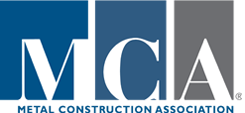

CHICAGO – September 22, 2016– The Metal Construction Association (MCA) has released a report identifying the top 11 drivers in the nonresidential construction industry. The report, based on data analysis, surveys, and interviews with industry leaders, was prepared by FMI, a leading management consulting and investment banking firm dedicated to engineering and construction, infrastructure, and the built environment. The top trends in the industry trends were identified as follows:
1) Talent Shortages and Management Succession Challenges
At the height of the recession, 30% of the commercial construction industry lost their jobs causing a lack of skilled workers as business picks up. The need to recruit and retain employees is key to attract the next-generation of millennials to the construction business, which is perceived as tough, dirty, dangerous and low paying among a high tech and career-oriented generation.
2) Greater Use of New Technologies
With more prefabrication and modularization, use of robotics and 3-D printing, construction is becoming more standardized and computerized. BIM models are playing a greater role in all aspects of the construction process.
3) Productivity Improvements Needed for Profitability
While use of BIM, prefabrication, modularization and green construction are necessary in construction manufacturing, at the contractor level, technology and planning are paramount to being profitable.
4) Changes in Construction Delivery Systems
A slow shift is being seen from the traditional design-bid-build or hard-bid approach to more collaborative or alternative delivery methods that were gaining popularity before the recession.
5) Owner Transition
As baby boomer leaders are getting to retirement age, the industry is facing a change in ownership among 50% of construction firms.
6) International Debt Problems
Although the U.S. has been enjoying a resurgent economy, European countries like Greece, Italy, Spain and Portugal are struggling. After years of rapid growth, China is also experiencing a slowdown in its economy, threatening the savings and investments made in a more bullish atmosphere in the last few years.
7) Forming Partnerships with Customers
A more customer-centric orientation is returning. Manufacturers and suppliers must match their marketing and delivery methods to the needs of the contractor and become partners in the process.
8) Healthier Companies
In order to survive the recession, companies had to get to positive cash flow (or at least neutral) in the new demand reality of the 2009-2011 period. This focus on efficiency created lower cost structures.
9) Growth Through Acquisition
The demand for attractive building products companies to purchase is high. Industry stakeholders are looking to realize overhead efficiencies and maximize nontraditional margin enhancements (risk management, technology, self-perform, etc.). Those companies realizing profitability in this way are well positioned to prosper as the construction market improves.
10) Consolidation
On the manufacturing distribution side, 2015 was a year of large company consolidation. Market conditions led to unprecedented merger activity among large players. Today, a seller can receive what the company deems a fair price, while a buyer feels there is still enough business ahead to make a decent return on the investment.
11) Mergers and Acquisitions Activity Benefit Buyers & Sellers
Pace and scale of activity are both up with both strategic and financial buyers. With demand high and the supply of attractive companies low, one would expect prices to increase, and they have.
These trends are expected to play role in shaping the nonresidential construction industry in the coming years and are important to considerations as companies make their strategic plans. The full report is available to MCA members at www.metalconstruction.com.
The Metal Construction Association (MCA) is a leader in promoting and expanding the use of metal in construction through marketing, research, technology and education. MCA members include metal roof and wall panel manufactures. Key trade associations serving the metal construction industry partnered with MCA in this study. The participants include: The American Iron & Steel Institute (AISI), The Aluminum Association (AA), Metal Roofing Alliance, National Frame Builders Association (NFBA), and the National Coil Coaters Association (NCCA).
###


